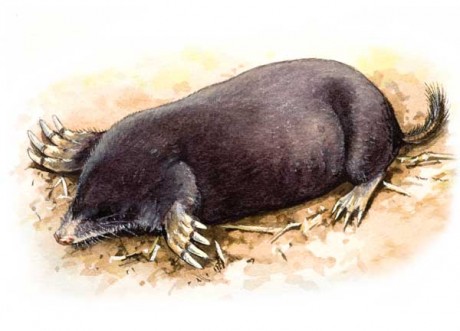Managing moles
It’s an ongoing task that can succeed using multiple control methods. Be smart, be legal, and good luck!
By Amy NeyWe’ve all seen them — the tunnels marring beautifully manicured parks, fairways and cemeteries. But it’s most frustrating when those miniature mole highways are in the lawn you have worked so hard to maintain.
Before trying to eradicate the invaders, take stock of the situation. Does the damage warrant trying various methods? Moles actually provide positive services: they aerate soil and mix the layers, they eat pest larvae including white grubs and Japanese beetles.
Who are they?
The three species of moles in North Carolina are the eastern mole, the hairy-tailed mole, and the star-nosed mole. Each is from 4–8 inches long with a protruding snout, gray to black fur, and clawed feet. They do not eat plant roots or bulbs, but dig tunnels in search of food, up to 150 feet of pathway per day. They eat mainly grubs, earthworms, ants and beetles, and consume them at 50–100 percent of their body weight each day. Moles prefer moist soil without much gravel or clay. They are active year-round. They tend to be solitary unless it is a female caring for her young, so it may be just one mole making a mess of your entire lawn.
Mole control
Moles are difficult to control. First, they have a variety of food sources, so if you eliminate one, they can switch to another. Second, having moles means you have good mole habitat. If you eradicate your one mole, another may take up residence. And third, because moles are a wild, non-game animal, you need a depredation permit to legally trap or kill them.
Some methods have no proven success: broken glass, pins, mothballs or hair in the tunnels; devices that emit sonic noises or vibrations; planting the caper spurge. Repellants containing castor oil have not been proven effective, and there is concern about the toxicity of castor beans. Methods illegal in North Carolina include using any type of chemicals, poisoning, fumigating or gassing.
While not guaranteed, the two main avenues of control are:
-
Reducing the food supply
White grubs are a major food source for moles, and these can be controlled by applying an insecticide to the ground surface while soil is very moist from rain or irrigation, in April–May or August–October while the larvae are feeding. White milky spore, a natural fungus, may reduce grubs and insects, but may take several years and the spores may not survive cold weather. Adding beneficial nematodes (microscopic, unsegmented worms) to your yard when the temperature begins to rise in the spring may help. Nematodes use insect pests as hosts to breed future generations, are totally harmless, and will die off when their food source is gone.
-
Trapping
Spear-type traps are the most effective. They can be found at farm supply stores. To find the best location to place the trap, stomp down all the tunnels and watch to see which are raised the next day. Do this for several days. Find a location that has been routinely re-tunneled, and stomp it down again. Place the trap in the center of the tunnel, ensuring that the soil on each side of it has been depressed so that it will not be visible to the mole inside the tunnel, and set it. Upon its next visit, the mole will dig itself into the trap. Dispose of deceased moles in a sanitary manner. If the trap has not been sprung within two days, repeat the process in a new place. One or two traps should be sufficient for a moderately sized lawn. All mole depredation requires a permit and must be reported to the NCWRC within five working days. Remember that removing moles doesn’t change your lawn’s habitat status.
You also can encourage natural predators such as snakes, owls and pets. Ask your county Cooperative Extension how to create beneficial habitat for native species.
Watch how to set a trap:
-
Share this story:


